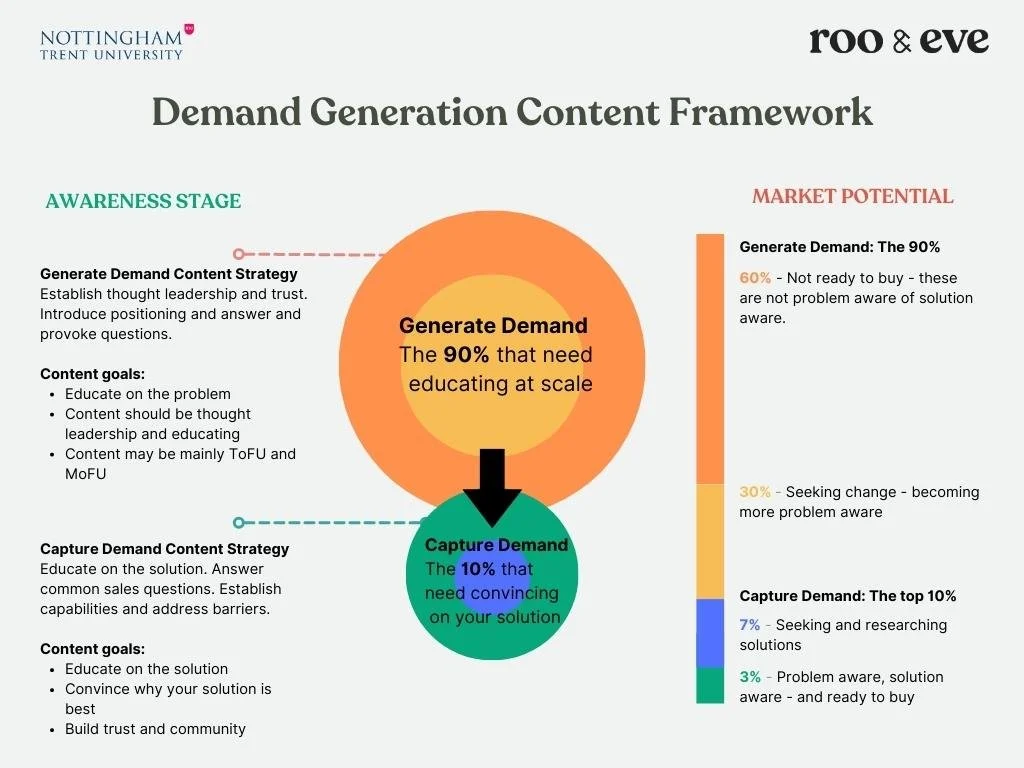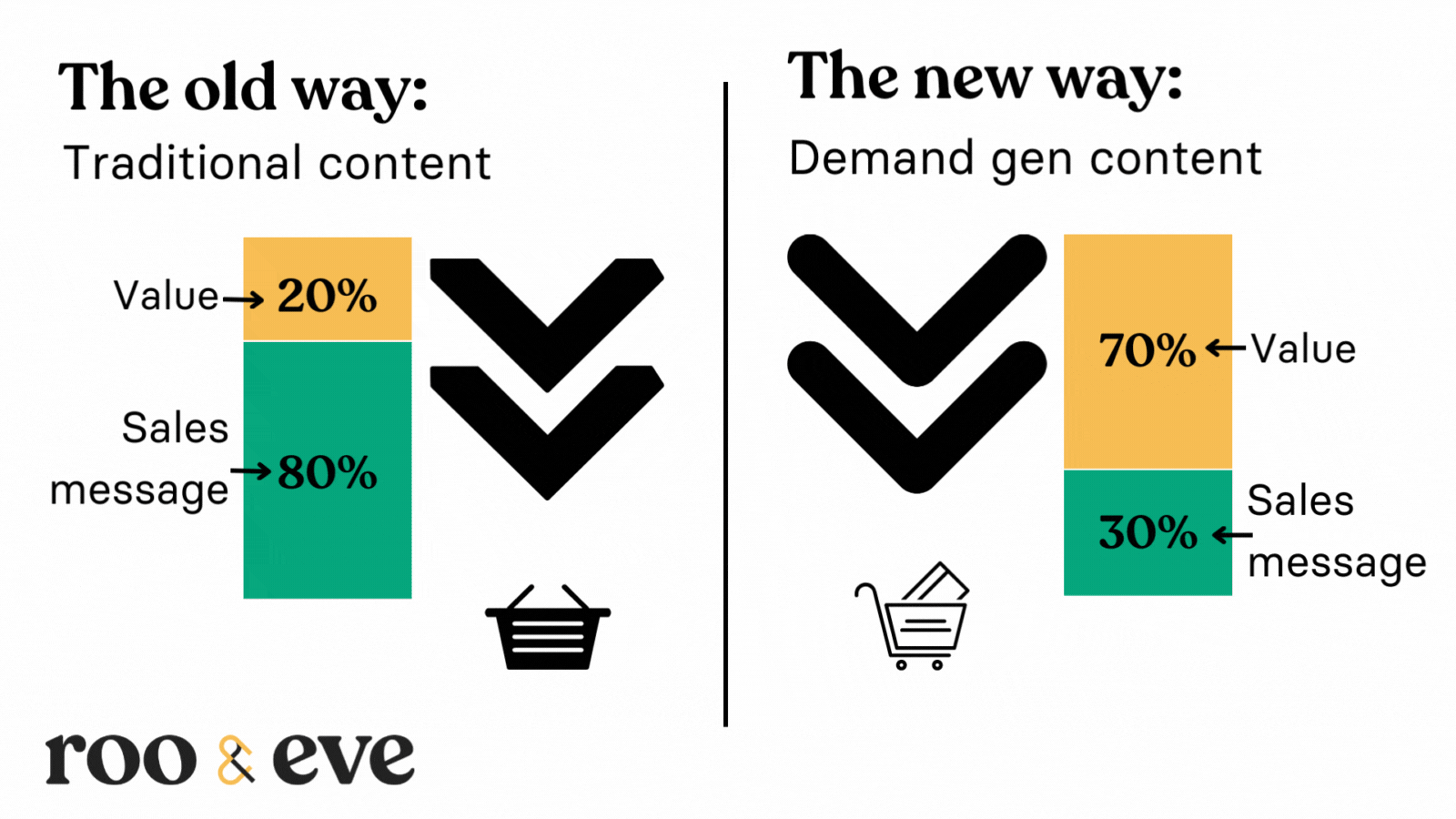A B2B Demand Generation Framework for Content Marketing
Feeling baffled by the latest B2B marketing tactics, channels, and buzzwords? Think you need to shift from lead gen to demand gen methods? Or just looking for inspiration to up-level your B2B marketing?
There’s a lot to navigate when grappling with the latest B2B marketing best practices, like how much focus to put on paid media vs brand building? Or if you should gate content?
For some time now, we have been hearing about the importance of a demand generation approach. But what does a B2B demand generation framework look like? And how can you use it to grow revenue and increase average order values?
In this article we’ll go over:
B2B demand generation: our approach
Introducing the demand generation content framework
Breaking down the demand generation content framework
Understanding the way B2B buyers buy today
Why the demand gen framework works
Let’s get started. 👇
B2B demand generation: our approach
We collaborated with Nottingham Trent University to create a framework for B2B demand generation (aka demand gen) for content marketing.
Our purpose: To discover how to win today’s B2B buyers in the era of self-service sales.
Most businesses start with tactics and wonder why their marketing isn’t working as well as it should.
On the other hand, when you use a framework:
A framework leads to strategy
Strategy directs tactics
Tactics bring results
But what does a solid framework look like for B2B demand gen, and specifically for content marketing?
Introducing the demand gen content marketing framework
Working in collaboration with a team of full-time MSc students from Nottingham Trent University, we created a framework to improve content marketing in the era of self-service sales. The aim of this work is to enhance the way B2B businesses engage, educate, and convert B2B buyers.
The framework builds on previous B2B marketing best practices. However, it’s a first of its kind, in our knowledge, in terms of a specific framework for B2B Demand Generation Content.
The demand generation content framework can be used and has been implemented by B2B businesses across all sectors globally, from fintech to SaaS, recruitment, consultancy, and IoT products.
Initial results demonstrate:
Higher conversion rates
Higher average order values
Increased engagement rates
Significantly higher quality leads
Strong revenue and return on investment 💸
The framework, considers two important aspects generating demand from the 90% of your target audience who are not yet ready to buy and capturing demand from the 10% seeking solutions and ready to buy.
Breaking down the demand gen content framework
In essence, the demand gen content framework breaks into two key parts:
Generate demand
Capture demand
Let’s look at each one.
Generate demand (90% of your audience)
Approximately 90% of your audience is not ready to buy at any given time. Of that 90%, around 60% are not problem-aware or solution-aware, and around 30% are seeking change and becoming more aware of their problems.
To put it simply, this segment of your audience needs educational content. We’ve found great results using thought leadership content to educate them on the problem and why it needs addressing. More on this here.
Capture demand (10% of your audience)
On the other hand, approximately 10% of your audience are problem aware, and either researching and seeking solutions (7%) or ready to buy now (3%).
This segment of your audience needs educating on the solution. Here you can answer common sales questions, establish trust, address any barriers, and essentially convince them about why your solution is best.
Now, we know buyers don’t simply fall into a perfect funnel, read everything you put out in chronological order and convert.
The decision process looks a bit more like this.
We created our framework as overlapping circles rather than a traditional funnel because buyers will often loop between educational thought leadership content (demand gen content) and product-led content (demand capture content), depending on:
how big their problem is at any given time and whether priorities change;
feedback from their colleagues who may raise issues they haven’t considered;
or if they decide to deal with the problem later.
And that’s why we always recommend merging content strategies.
After all, you never know where a buyer is in their journey, when they might need more education, or when they are ready to buy. More on this here.
So make it easy for them. Build strong content clusters and internal linking strategies, repurpose content for distribution channels, and create customer journeys with today’s buyer’s needs at the heart. That’s why this approach works so well.
Ultimately, it aligns with the way B2B buyers buy today.
Understanding the way B2B buyers buy today
Traditionally, B2B businesses operated as sales companies with SDRs reaching out to some sort of list and qualifying leads. Marketing is often ignored as a growth lever, and it’s not uncommon to find a marketing team of 5 supporting a sales team of 70.
The problem is: B2B buyers now want to self-serve. According to Gartner, 79% of buyers consume three to five pieces of content before they ever talk to sales.
Think about your current buyer journey. If it relies on sales reps to support with educating prospects, then you’re likely behind already.
Today’s B2B buyers are looking for information before they ever talk to someone – and they’re looking for content for every stage of the buyer journey – from problem identification to solution exploration and supplier selection.
This is the big disconnect.
If B2B’s fail to align to the way buyers want to buy, they will struggle.
What this means is that marketing needs to play a role at every stage of the buyer journey. This requires a demand generation content framework.
Instead of handing a cold lead off to sales – you need to provide content for every stage of the journey and continue to nurture buyers across the entire buyer process. This means providing content so that buyers can effectively ‘self-serve’ through the buyer process.
Why the demand gen framework works
Some frameworks tend to complicate things. We have been guilty of this (more than once) in the past. But for most data and tech B2B’s, a simple approach works best.
Why?
It’s very easy to waste a lot of time and money really fast.
One of the biggest challenges that many B2B businesses face is generating enough high-quality inbound leads.
This leads to businesses spending more on performance marketing channels like PPC and paid media in a bid to try and get as many leads through the door.
A demand gen content framework aligns your content to specific pain points and stages of the buyer journey to convert prospects into buyers and drive revenue.
This makes it easier to identify your content needs, determine where to distribute, and what to measure.
Next steps 🚀
We want to make marketing more of a growth lever for B2B businesses. That’s why we collaborated with Nottingham Trent University to develop a framework to articulate the approach we’ve been following for the last several years.
A demand gen content framework is crucial to help your business operate more efficiently and uncover the right strategies for sustainable long-term revenue growth.
Of course, it’s not always quite as easy to get buy-in, and it doesn’t have to be in perfect order.
As always, use this as a framework, not as a rule book. 🧩
Talk to us for a free strategy call.
Special thanks to Nottingham Trent University, including Harkirat Singh, Yashwathy Marudhachalam, Palkan Parikh, Mathurada Patanasak, and Akshay Suresh.






